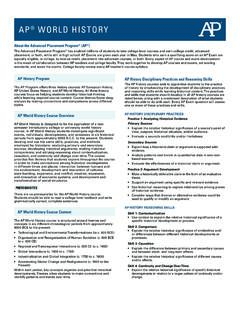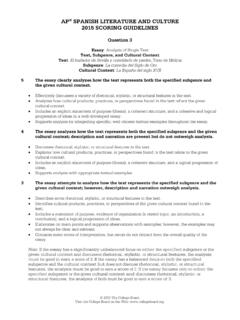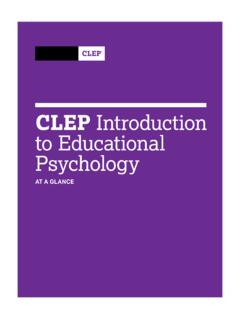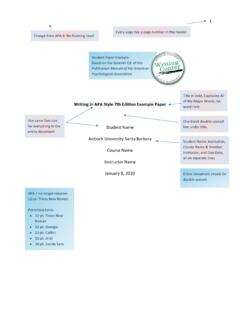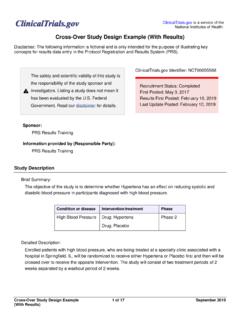Transcription of AP Seminar Performance Assessment Task 1
1 2017AP Seminar Performance Assessment Task 1 Sample Student Responses and Scoring Commentary 2017 The College Board. College Board, Advanced Placement Program, AP, AP Central, and the acorn logo are registered trademarks of the College Board. Visit the College Board on the Web: Central is the official online home for the AP Program: : RIndividual Research Report RScoring Guideline RStudent Samples RScoring Commentary AP Seminar Rubric 2016-17: Performance Task 1 2016 The College Board2AP Seminar Performance Task 1 | 2016-2017 Scoring GuidelinesComponent 1 of 2: Individual Research ReportPerformance LevelsRowContent Area/ProficiencyLowMediumHighPoints (Max)1 Understand and Analyze ContextThe report identifies an overly broad or simplistic area of investigation and/or shows little evidence of research.
2 A simplistic connection or no connection is made to the overall problem or report identifies an adequately focused area of investigation in the research and shows some variety in source selection. It makes some reference to the overall problem or issue. The report situates the student s investigation of the complexities of a problem or issue in research that draws upon a wide variety of appropriate sources. It makes clear the significance to a larger context. 62462 Understand and Analyze ArgumentThe report restates or misstates information from sources. It doesn t address reasoning in the sources or it does so in a very simplistic report summarizes information and in places offers effective explanation of the reasoning within the sources argument (but does so inconsistently).The report demonstrates an understanding of the reasoning and validity of the sources' arguments.
3 * This can be evidenced by direct explanation or through purposeful use of the reasoning and conclusions. 62463 Evaluate Sources and EvidenceThe report identifies evidence from chosen sources. It makes very simplistic, illogical, or no reference to the credibility of sources and evidence, and their relevance to the report in places offers some effective explanation of the chosen sources and evidence in terms of their credibility and relevance to the inquiry (but does so inconsistently). The report demonstrates evaluation of credibility of the sources and selection of relevant evidence from the sources. Both can be evidenced by direct explanation or through purposeful use. 62464 Understand and Analyze PerspectiveThe report identifies few and/or oversimplified perspectives from sources.**The report identifies multiple perspectives from sources, making some general connections among those perspectives.
4 **The report discusses a range of perspectives and draws explicit and relevant connections among those perspectives.** 6246AP Seminar Rubric 2016-17: Performance Task 1 2016 The College Board3AP Seminar Performance Task 1 | 2016-2017 Scoring GuidelinesComponent 1 of 2: Individual Research Report (continued) Performance LevelsRowContent Area/ProficiencyLowMediumHighPoints (Max)5 Apply Conventions The report includes many errors in attribution and citation OR the bibliography is inconsistent in style and format and/or report attributes or cites sources used but not always accurately. The bibliography references sources using a consistent report attributes and accurately cites the sources used. The bibliography accurately references sources using a consistent Conventions The report contains many flaws in grammar that often interfere with communication to the reader.
5 The written style is not appropriate for an academic report is generally clear but contains some flaws in grammar that occasionally interfere with communication to the reader. The written style is inconsistent and not always appropriate for an academic audience. The report communicates clearly to the reader (although may not be free of errors in grammar and style). The written style is consistently appropriate for an academic *For the purposes of AP Seminar , validity is defined in the glossary of the CED as the extent to which an argument or claim is logical. ** For the purposes of AP Seminar , perspective is defined in the glossary of the CED as a point of view conveyed through an argument. Additional ScoresIn addition to the scores represented on the rubrics, readers can also assign scores of 0 (zero) and NR (No Response).
6 0 (Zero) A score of 0 is assigned to a single row of the rubric when the response displays a below-minimum level of quality as identified in that row of the rubric. For rows 1 to 4, if there is no evidence of any research ( it is all opinion and there is nothing in the bibliography, no citation or attributed phrases in the response) then a score of 0 should be assigned. Scores of 0 are assigned to all rows of the rubric when the response is off-topic; a repetition of a prompt; entirely crossed-out; a drawing or other markings; or a response in a language other than (No Response) A score of NR is assigned to responses that are head: DEINSTITUTIONALZATION: LEAVING PATIENTS BEHIND 1 Deinstitutionalization: Leaving Patients Behind AP Seminar 2017 Word Count: 1306 PT1_IRR_A 1 of 8 2017 The College Board.
7 Visit the College Board on the Web: : LEAVING PATIENTS BEHIND 2 Introduction News of the deinstitutionalization movement has passed by, unnoticed since its commencement in the 1960 s. However, growing concerns over poverty, prison overcrowding, and civil rights of mentally disabled patients call for recognition and deep understanding of deinstitutionalization as a major contributor to these problems. According to Lamb, a professor at University of Southern California School of Medicine, Los Angeles and Bachrach, veteran author of 41 articles on the topic of deinstitutionalization, deinstitutionalization is defined as the replacement of state or federal run psychiatric hospitals with community-based alternatives (Lamb & Bachrach, 2001). The government implemented this policy of deinstitutionalization because of the belief that mental hospitals were cruel and inhumane, hope that new medications [opposed to the ineffective treatment from the institutions] offered a cure, and the desire to save money (Yohanna, 2013).
8 Overall, the government expected deinstitutionalization to improve the lives of the mentally ill. Since the commencement, the program strived to develop independence among patients by increasing employment and interaction with others. Unfortunately, these positive outcomes occur only where mental community services are well-established and maintained (Kliewer, McNally, & Trippany, ). In actuality, a majority of the released patients experience unintentional, negative consequences of deinstitutionalization such as homelessness, incarceration, and isolation due to the absence of the promised community care. Patient Homelessness The absence and lack in quality of community-based mental programs contributes to the failure of the deinstitutionalization movement to improve the lives of mental patients.
9 The major obstacle facing the success of deinstitutionalization is limited funding for mental centers which results in an unprofessional staff and ineffective services (Kliewer, McNally, & Trippany, ). PT1_IRR_A 2 of 8 2017 The College Board. Visit the College Board on the Web: : LEAVING PATIENTS BEHIND 3 Flory and Friedrich, co-directors of the National Alliance for the Mentally Ill Long-term Care Network, provide examples of the effects caused by limited funding through the complaints of families who have directly experienced the unsuccessful community centers. Many described the lack of 24-hour supervision when needed. They also delineate their experience with the revolving door syndrome, the frequent transportation of patients caused by the lack of adequate housing. One woman explains how her schizophrenic son had been moved in the system 62 times; thus, her son remained ill for 20 years due to lack of treatment (Flory & Friedrich 1999).
10 Revolving door syndrome causes patient instability and leads to forced homelessness because of the brief treatment duration and forced discharge from government institutions. Madianos, president of the World Association for Psychosocial Rehabilitation and professor of general and social psychiatry at the University of Athens, delineates the direct correlation between the economic level of a country and availability of mental health programs; only of the impoverished countries had available services while of the wealthy countries had available services (Madianos, 2010). Thus, his study supports the concept that community services assist countries in escaping poverty by housing and treating the mental patients who make up a third to a half of all homeless adults (Lamb & Bachrach, 2001). The failure of the deinstitutionalization movement caused by insufficient funding of community mental centers results in increased patient homelessness after they experience the revolving door and realize they have no place to stay.

